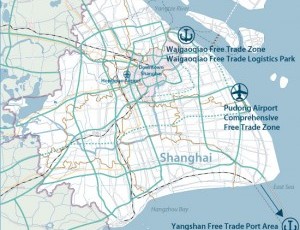Choosing an Office Location in Shanghai
 Say you’ve made the decision to take your company to China. You’ve identified Shanghai as the right place to start. Maybe you’ve even heard something of what the Shanghai Free Trade Zone can do for your business. But in a city of over 6,300 km2, and the largest in the world by population, where does one begin to look for an office?
Say you’ve made the decision to take your company to China. You’ve identified Shanghai as the right place to start. Maybe you’ve even heard something of what the Shanghai Free Trade Zone can do for your business. But in a city of over 6,300 km2, and the largest in the world by population, where does one begin to look for an office?
To guide you through this process, here we present the latest information on commercial districts in Shanghai — including trends in vacancy, rental rates and market expansion — and examine the state of commercial property in the Shanghai Free Trade Zone (FTZ).
Puxi or Pudong?
The first decision to make when hunting for office space in Shanghai is which side of the Huangpu River your company will be based on. Puxi, “west of the Huangpu,” is the older of the two and home to a densely concentrated urban population. Its sub-districts include Xujiahui, Luwan, and Jing’an (together forming the former French Concession), as well as Huangpu (site of the historic Bund), and Honqiao (home of Shanghai’s domestic airport).
The heart of old Shanghai, Puxi has seen slightly cheaper average commercial rents than its eastern counterpart Pudong since early 2013. In the first quarter of 2014, average rents for offices in Puxi fell 2.2 percent (quarter-on-quarter) to RMB 8.8 per sm per day, according to Knight Frank. This was enough to bring down Shanghai’s overall office rents, despite rising rents in neighboring Pudong. This trend is predicted to continue in Puxi, where a flood of new supply of Grade-A offices in 2014 may lead to a further 2-percent decrease in rents by the end of 2014. Total office space in Puxi is expected to grow by 2.3 million sq m through 2020.
Pudong, “east of the Huangpu,” is the newer and flashier of the two districts, with its modern skyscrapers emblematic of post-reform China. Notably, it is home to the Lujiazui district, designed to house the city’s financial services industry. The amount of Grade-A office space in Lujiazui grew by an astounding 95 percent between 2000 and 2012, to 1.7 million sq m, but was still unable to keep up with demand. The rapid expansion of commercial space in Pudong in recent years is the result of vigorous government promotion of the area.
Rents in Pudong rose to an average of RMB9.4 per sm per day (an increase of about 1.8 percent) in the first quarter of 2014, attributed to strong demand from domestic companies that has pushed vacancy down to its lowest level in almost 7 years. The second phase of the Lujiazui Century Financial Plaza to be completed later this year will add an additional 220,000 sq m of space to Pudong’s market.
Shanghai FTZ
Pudong is also home to the Shanghai Free Trade Zone (FTZ), launched in September 2013 as a testing ground for market reforms and the smoother facilitation of foreign investment into China. Combined, the FTZ consists of the Waigaoqiao Free-Trade Zone, Waigaoqiao Bonded Logistics Park, Yangshan Bonded Port Area and Pudong Airport Comprehensive Bonded Zone.
Office rents in the FTZ ballooned following its inauguration, as a wave of enterprises rushed in to take advantage of the zone’s preferential regulatory environment; rents peaked in early 2014 at RMB5.90 per square meter per day. Recently, when cross-border trading between the Shanghai and Hong Kong stock exchanges was announced in April 2014, this set off a wave of renewed interest in commercial property in the FTZ. According to the Shanghai Statistics Bureau, close to 10,000 businesses had registered within the FTZ as of June 2014—661 of which were foreign-invested enterprises.
At present, a large proportion of offices in the zone are being held by Chinese speculators betting on the future desirability of incorporating in the zone. Until additional reforms are implemented, however, many companies are likely to hold on to these properties but conduct their main business operations outside of the FTZ, leading some analysts to speculate about a growing property bubble in the zone. Further complicating the situation is the fact that large amounts of space in the FTZ were originally given over to logistics-use rather than for offices.
In response, in April 2014, the Shanghai Municipal Government implemented measures to rezone certain industrial districts for offices and R&D, including land within the FTZ. However, owing to the distance between the FTZ’s four districts and Shanghai’s existing central business districts, analysts believe it is unlikely that the zone will become a major commercial hub in the short- to medium-term future. Fortunately, enterprises are permitted to register in the FTZ using a virtual office, rather than an actual physical location, for a cost of RMB20,000 – 30,000 and thereby enjoy the best of both worlds.
Future Directions
The future development of the commercial real estate market in Shanghai will be significantly informed by the Chinese Government’s twin goals of making Shanghai into an international financial hub by 2020 and shifting the national economy away from manufacturing and toward domestic consumption. While these campaigns are likely to exert upward pressure on commercial rents in Shanghai, increasing competition from nearby satellite cities to attract commercial tenants will eventually force the municipal government to implement response measures; for example, introducing thorough-going reforms in the FTZ to justify the higher costs of maintaining an office there.
Overall, Grade-A office space in Shanghai is estimated to increase 80 percent between 2013 and 2020, to a total of 13 million sq m. This will be the strongest growth of any Asia-Pacific business hub, including Mumbai, Tokyo, Singapore and Hong Kong. Vacancy, which peaked during the global financial crisis at around 17 percent and has since held steady between 5 and 10 percent, is predicted to remain low, under 10 percent through the year 2020.
Asia Briefing Ltd. is a subsidiary of Dezan Shira & Associates. Dezan Shira is a specialist foreign direct investment practice, providing corporate establishment, business advisory, tax advisory and compliance, accounting, payroll, due diligence and financial review services to multinationals investing in China, Hong Kong, India, Vietnam, Singapore and the rest of ASEAN. For further information, please email china@dezshira.com or visit www.dezshira.com.
Stay up to date with the latest business and investment trends in Asia by subscribing to our complimentary update service featuring news, commentary and regulatory insight.
 Guide to the Shanghai Free Trade Zone
Guide to the Shanghai Free Trade Zone
In this issue of China Briefing, we introduce the simplified company establishment procedure unique to the zone and the loosening of capital requirements to be applied nation wide this March. Further, we cover the requirements for setting up a business in the medical, e-commerce, value-added telecommunications, shipping, and banking & finance industries in the zone. We hope this will help you better gauge opportunities in the zone for your particular business.
Comparison: Prime ‘Grade A’ Office Rental Prices in China
The Disproportionate Rise of China’s Real Estate Market
- Previous Article Logistics, Warehousing and Transportation in China (Part 1)
- Next Article Logistics, Warehousing and Transportation in China (Part 2)

























